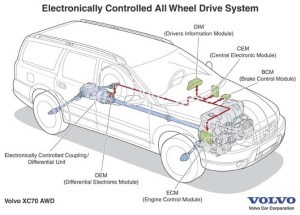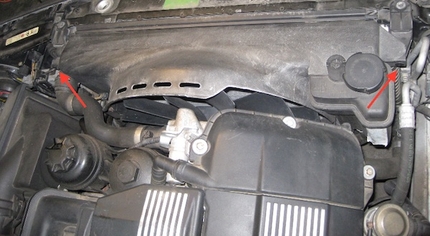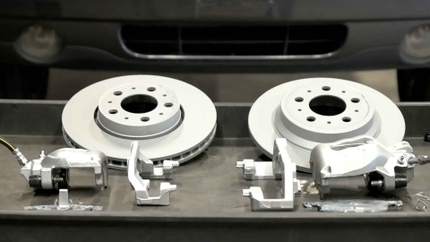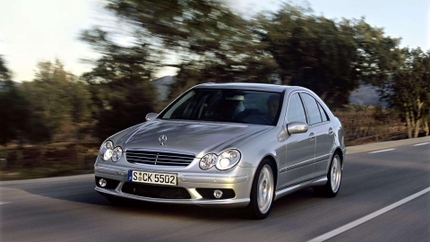- 04/08/2015
- 3 Min Read
- By: Noah Jenkins
Diagnosing Volvo P2 AWD System Failure Symptoms
One year ago my family purchased a 2004 Volvo XC70. It seemed that not too long after owning it, the AWD would fail to engage under certain circumstances and the shortly after that it failed to engage at all. When the system fails, you are left with a vehicle that is still completely drivable as before (we drove ours 30k miles before resolving the issue), however, your once-AWD vehicle is now front wheel drive only. In some of the earlier Volvo models with AWD, such as the P80 V70XC/V70R/S70 AWD models, owners would simply remove the driveshaft from their vehicle and run it as FWD to avoid a costly repair. Before deciding to do this, my suggestion is to diagnose why your AWD system is failing or has failed first and go from there. A system that is working properly and smoothly is sure to add value to your car due to the number of neglected or deleted AWD systems on the Volvo used marketplace.
I suspected failure of our XC70's AWD when I was at a stoplight on a slight incline. The light turned green and I proceeded to apply the throttle a little too aggressively. I noticed the traction control light came on flashing and I even heard a few "chrips" from the front tires. While at this point I did not automatically assume the system had failed but I was skeptical of it operation. *If* the vehicle did have AWD, does it really have enough power to chirp the tires on a dry road to the point where the traction control would engage?
Testing your AWD system
Slippery Surface Test
In order to test your AWD system, get the vehicle into a situation where low-traction is possible. I drove our car into a grassy field after it had just rained so the grass was nice and slick. The field was privately owned and had plenty of space. Whichever low-traction situation you get your vehicle in, be sure you can get it out FWD only in worst case! Make sure all four tires are on this surface.
Place your vehicle in gear and aggressively give it throttle to encourage traction loss. There is no need to floor it, just enough to break traction.
At this point, one of two things will happen:
Step 1: The vehicle will surge forward with all for wheels turning. The Haldex AWD system is virtually instantaneous when it detects slip in your front wheels to send power to the rears. Your traction control light may flash a few times. If the car powers through it and moves forward, AWD is functioning as it should.
Step 2: The vehicle will struggle for traction and you will feel that the front wheels are spinning continuously. You may slowly proceed forward. (In our XC70, this happened and also the traction control yellow light was flashing continuously in the dash and the vehicle seemed to go nowhere.). The AWD system is not functioning if this is the case.
Spinning Driveshaft Test
After testing the AWD system on the wet grass, I was already 99 percent sure that my system was not working, however, I did one more test just to be sure (you can just do this one if you prefer).
Step 1: Jack the vehicle up with the rear wheels both off the ground. Be sure to do this on a level surface and make sure the car is in park.
Step 2: Once both wheels are off the ground, try and spin one of the wheels or the driveshaft itself. If they spin freely, again, with the vehicle in park and the front wheels on the ground. Your AWD is inoperative.
Diagnosing the Failure
There are different generations of the Haldex AWD system used on the P2 Volvos, however the principle behind their operation is more or less the same. The Haldex systems use a set of clutch packs bathed in a hydraulic fluid. When wheel spin is detected, a mechanical or electromechanical (in the later generations) pump engages and pressurizes the fluid which engages the clutches and power is transferred. The engines power comes from an Angle Gear (bevel gear) which is connected to the transmission. There are two splined sleeves at either end of the angle gear which are also engaged. Based on the two tests above, you can narrow down why the AWD system is failing.
My Car passed the "spinning driveshaft test" but failed the "slippery surface test".
If this happens, chances are you are having problems with the Haldex viscous coupler at the rear of the vehicle.
-Start by checking for any leaks around the viscous coupler. If there is a lack of fluid the the system will not be able to function properly.
-If no leaks, change the fluid. The Haldex oil can degrade over time and it will lose its high viscosity and cause the clutches either not to engage or engage sporadically.
-Depending on the generation of Haldex, one or more of your sensors/pumps may have gone bad. Bring your vehicle to the dealership or an independent mechanic and have a diagnostics done. This would reveal any DEM codes indicating something with your Haldex unit has failed.
My car failed both tests.
If your car fails both of these test it does not necessarily mean that you are having issues with both your angle gear and Haldex coupler. Most times this is the case (this was the case with our XC70).
What had happened was the sleeve on the angle gear was stripped and therefore there was no engagement of the driveshaft to the rear wheels. Hence why the driveshaft could be spun freely. Most likely, this is your problem. The dealership had suggested to us that we replace the entire angle gear assembly as they deemed the whole thing had failed. This was a repair that would be north of $2,000! Since the collar sleeves are replaceable parts, we decided to change that along with the oil seals around it and see if that would give us AWD. It was worth a try since the sleeve is much less expensive than a whole angle gear.
There are many DIY guides on how to replace the sleeve on different Volvo forum websites.
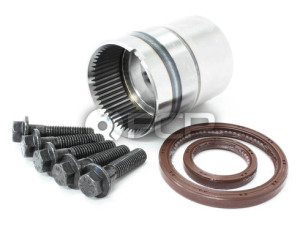
Replacement Parts
Volvo Angle Gear Sleeve Service Kit - Genuine Volvo 30787988
Volvo Angle Gear Collar Sleeve - Genuine Volvo 9495034
Its also a good idea to change your angle gear oil at the same time. Please note however, that this oil is different than that used in the viscous coupler.
Preventing Failure
While the Volvo P2 AWD systems may seem fragile, they are actually very good reactive systems. The car runs mainly as front wheel drive which will aid in its overall efficiency, but can be seamlessly and quickly engaged when needed. You can do things to preserve your working AWD system by ensuring all four tires are the same brand and size (also have them rotated at every oil change) and replacing your fluid at specified intervals.

